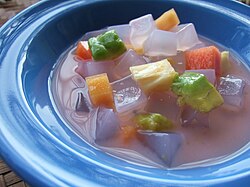Nata de coco

Nata de coco are the translucent cubes in this fruit salad.
|
|
| Type | Confectionery or dessert |
|---|---|
| Place of origin | Philippines |
| Main ingredients | Coconut water |
| |
|
Nata de coco is a chewy, translucent, jelly-like food produced by the fermentation of coconut water, which gels through the production of microbial cellulose by Acetobacter xylinum. Originating in the Philippines, nata de coco is most commonly sweetened as a candy or dessert, and can accompany a variety of foods, including pickles, drinks, ice cream, puddings, and fruit mixes.
Nata de coco was first created in 1973 in the Philippines by attempting to preserve coconut water as a jelly-like substance. It was named after the phrase “cream of coconut” in Spanish. Until in the 19th century, the demand for coconuts increased. Products from coconuts became a major export product of the Philippines, including nata de coco.
Nata de coco is mainly made out of water, so it has slight amount of nutrition. One cup of nata de coco (118 grams) contains 109 calories, 1 gram of protein, and 7 grams of carbohydrates. Most of the time, it has been considered to be a healthy food because it has a lot of fiber to help in digestion and it gives less calories compared to other desserts in the same amount.
Commercially made nata de coco is made by small farms in Thailand, Malaysia, the Philippines, and Indonesia, especially in the Special Region of Yogyakarta, and in Thailand, it is commonly sold in jars.
The primarily coconut water dessert is produced through the following steps:
Nata de coco can be consumed on its own, but it can be used as an ingredient as well, and can be found in the following foods:
...
Wikipedia
